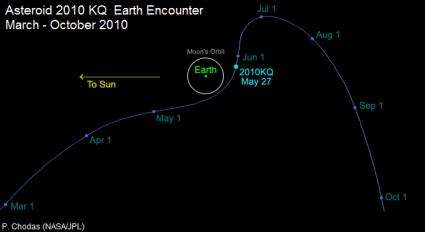Graphic depicting the trajectory of near-Earth object 2010 KQ. Image credit: NASA/JPL
(PhysOrg.com) -- Scientists at NASA's Near-Earth Object Program Office at NASA's Jet Propulsion Laboratory in Pasadena, Calif., have determined that a small object that safely passed Earth on May 21 is more than likely an upper-stage of a rocket that carried a spacecraft on an interplanetary trajectory.
"The orbit of this object is very similar to that of the Earth, and one would not expect an object to remain in this type of orbit for very long," said Paul Chodas, a scientist at NASA's Near-Earth Object Program Office at the Jet Propulsion Laboratory in Pasadena, Calif.
Observations by astronomer S.J. Bus, using the NASA-sponsored Infrared Telescope Facility in Mauna Kea, Hawaii, indicate that 2010 KQ's spectral characteristics do not match any of the known asteroid types, and the object's absolute magnitude (28.9) suggests it is only a few meters in size.
2010 KQ was discovered by astronomer Richard Kowalski at the NASA-sponsored Catalina Sky Survey in the mountains just north of Tucson, Ariz., on May 16. Five days later, it made its closest approach to Earth at a distance just beyond the moon's orbit. The object is departing Earth's neighborhood but will be returning in 2036.
"At present, there is a 6 percent probability that 2010 KQ will enter our atmosphere over a 30-year period starting in 2036," said Chodas. "More than likely, additional observations of the object will refine its orbit and impact possibilities. Even in the unlikely event that this object is headed for impact with Earth, whether it is an asteroid or rocket body, it is so small that it would disintegrate in the atmosphere and not cause harm on the ground."
NASA detects, tracks and characterizes asteroids and comets passing close to Earth using both ground- and space-based telescopes. The Near-Earth Object Observations Program, commonly called "Spaceguard," discovers these objects, characterizes a subset of them, and plots their orbits to determine if any could be potentially hazardous to our planet.
Provided by JPL/NASA
























